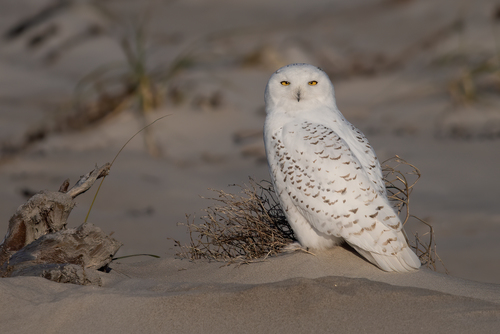
Snowy Owl
The Snowy Owl (*Bubo scandiacus*) is a large, white owl known for its striking appearance and adaptations to Arctic environments. It plays a crucial role as a top predator in the tundra ecosystem, primarily controlling populations of lemmings and other small rodents. Unlike many other owl species, the Snowy Owl is often active during the day, especially during the breeding season's continuous daylight. Culturally, the Snowy Owl has held significance in various northern Indigenous communities, often symbolizing wisdom, patience, or appearing in folklore.
52-71 cm
Length
125-150 cm
Wingspan
Vulnerable
Conservation Status
Distribution
Circumpolar distribution, breeding in the Arctic regions of North America, Europe, and Asia. During winter, some populations migrate south to southern Canada, the northern United States, Europe, and Asia. They exhibit irruptive migrations, with large numbers moving south in years when prey is scarce.
Lifespan
In the wild, Snowy Owls typically live around 10 years. In captivity, they can live much longer, sometimes over 20 years.
Snowy Owl's Habitat
Habitat Types
Arctic tundra, Open grasslands, Coastal dunes, Marshes
Climate Zones
Arctic, Subarctic, Temperate (during winter migrations)
Adaptations
Dense plumage provides exceptional insulation against extreme cold. Feathered feet and legs further reduce heat loss. Their large size and powerful talons enable them to capture a variety of prey in harsh conditions.
Variations
No currently recognized subspecies, although some minor regional variations in size and plumage darkness may exist.
Appearance
Breeding Plumage
Adult males are almost pure white, while females and juveniles have varying amounts of dark brown barring. Plumage remains relatively consistent throughout the year, although it may become slightly worn during the breeding season.
Seasonal Feather Changes
Minimal seasonal variation; older birds tend to be whiter.
Sex Based Plumage Differences
Significant sexual dimorphism; males are whiter, females are more heavily barred.
Notable Features
Large, round head without ear tufts, Bright yellow eyes, Black beak, Heavily feathered feet and legs
Diet and Feeding
Primary Foods
Lemmings, Voles, Other small rodents, Birds (including waterfowl and seabirds), Rabbits (occasionally)
Foraging Behavior
Snowy Owls are primarily sit-and-wait predators, perching on elevated locations and scanning for prey. They also hunt on the wing, flying low over the tundra. They are known for their keen eyesight and hearing, allowing them to detect prey even under snow cover.
Specializations
Their sharp talons and powerful grip are adapted for capturing and killing prey. Their facial disk helps to funnel sound to their ears, enhancing their ability to locate prey by sound.
Seasonal Diet Variations
Diet varies depending on prey availability. During the breeding season, lemmings often form the bulk of their diet. In winter, they may consume a wider variety of prey, including birds and larger mammals.
Behavior
Social Structure
Generally solitary, except during the breeding season when they form pairs. They may congregate in areas with abundant prey during winter.
Communication
Hoots (primarily by males), Hisses and screams (when threatened), Wing-clapping (during courtship)
Migration
Some populations are resident, while others are migratory or irruptive. Irruptive migrations are driven by fluctuations in prey populations.
Territorial or Group Behaviors
During the breeding season, Snowy Owls are highly territorial, defending their nesting area from other owls and predators. Outside of the breeding season, they are generally less territorial.
Conservation
Threats
Climate change (leading to habitat loss and changes in prey availability), Collisions with vehicles and power lines, Human disturbance, Exposure to toxins (e.g., rodenticides)
Protection Programs
Monitoring of populations and breeding success, Research on the impacts of climate change, Efforts to reduce collisions with infrastructure
Local National Laws
Protected under the Migratory Bird Treaty Act in the United States and Canada, and similar legislation in other countries.
Population Trend
Decreasing
Population Estimates
Estimates vary, but the global population is thought to be less than 30,000 individuals.
Interesting Facts
Snowy Owls can swallow small prey whole.
They later regurgitate pellets containing indigestible parts like bones and fur.
They are one of the heaviest owl species in North America.
Their weight is an adaptation to surviving in cold climates.
Their eyes are fixed in their sockets.
To compensate, they can rotate their heads up to 270 degrees.
Snowy Owls have been known to hunt and catch fish.
This behavior is more common in coastal areas or when other prey is scarce.
Faqs about Snowy Owl
Why are Snowy Owls white?
Their white plumage provides camouflage in their snowy Arctic habitat, helping them to blend in with their surroundings and ambush prey.
Do Snowy Owls hoot?
Males do hoot, especially during the breeding season, to attract mates and defend their territory. Females have a higher-pitched call.
Where can I see a Snowy Owl?
During the breeding season, they are found in the Arctic tundra. In winter, they may be seen in open habitats in southern Canada, the northern United States, and parts of Europe and Asia.
What is an irruption?
An irruption is a sudden, large-scale movement of Snowy Owls (or other birds) outside of their normal range, usually driven by a shortage of food.
Copyright @ Nature Style Limited. All Rights Reserved.
 English
English